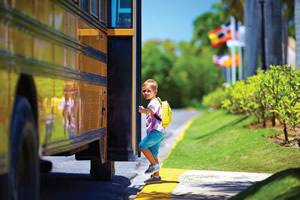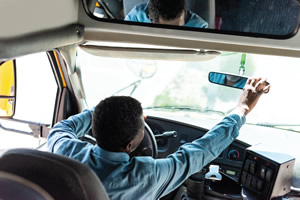The Business of School Buses
- By Michael Fickes
- 10/01/18

PHOTO © OLESIA BILKE
Does your son or daughter take a school bus back and forth to school? Twenty-five million students take school buses every year, according to the American School Bus Council. The Council’s statistics also note that school buses log about 5.7 billion (with a “B”) miles every year.
Within this huge undertaking, each school district’s transportation effort poses many challenges. There are administrative challenges—assigning students to buses and bus stops. Today, many systems are assigning students to seats. Then, of course, there are serious business questions: Should the district run its school bus system itself or subcontract to a provider? Finally, there must be effective ways to monitor students and keep them safe on the bus.
Hillsborough District Schools in Tampa, Fla., owns and operates its own bus transportation system. “Most districts in Florida do own their student transportation systems,” says Jim Beekman, Hillsborough’s general manager for transportation.”
Hillsborough worked up business plans to evaluate the question of owning or subcontracting various components of its transportation system. “We do subcontract some operations—not the buses—but we subcontract vans for special education students.”
Hillsborough also uses vans to satisfy the requirements of McKinney-Vento Act as amended in 1990. Among a number of requirements related to aiding the homeless, McKinney-Vento touches on school transportation. McKinney-Vento covers students that become homeless and must move in with relatives or into a homeless shelter. If those students end up moving out of their school district, they have the right to continue attending their original school. “According to McKinney-Vento, we have to transport those students who opt to remain in the school they have been attending,” says Beekman. “We provide van service for those students.”
Then, of course, there are administrative issues to deal with: who will ride the bus. Where will the bus pick them up in the morning? What time will it pick them up? Where will the bus drop them off in the evening? What route will each bus follow morning and evening?
The eighth largest school district in the country, Hillsborough buses pick up about 82,000 students every morning and take them home after school.
“To manage such operations, school transportation departments use routing and planning software and GPS tracking software. We use a software package called Edulog to log all of our students into a database. Then we build routes backwards from each of the schools.
The law protects school buses and their passengers. Car drivers must stop when they see a school bus parked on the side of the road with its “Stop” sign displayed.
School bus design also promotes safety. A concept called compartmentalization required by NHTSA requires seats to be padded front and back to protect children during a crash, even without seatbelts, which have not been universally required on school buses.
As of 2017, eight states required seat belts in school buses. They include Arkansas, California, Florida, Louisiana, Nevada, New Jersey, New York, and Texas. The remaining states do not currently require seat belts on school buses.
In early September of this year, however, a new school bus seat belt law was introduced in Congress. If enacted, it would require all school buses in all states to provide seatbelts, and students would be required to use them.
One of the bill’s provisions would provide grants to assist school districts in paying for seat belt modifications.
Individual states have enacted laws to ensure their school buses are safe. “In Florida, our buses must be inspected every 30 days,” Beekman says. “Our mechanics do the inspections—but before they can inspect, they go through state training and testing to become certified to conduct school bus inspections.”
Another issue that has gained importance in today’s world is security. Hillsborough parks its buses in a gated area at night. In the morning, each driver does a pre-trip inspection on his or her bus to make sure everything is in working order. Then at the end of the school day, the drivers do another pre-trip inspection before picking up the students and taking them home.
Of course, security concerns also include the students themselves. “All student bus riders must be listed on the driver’s log, which records who gets on and off and where,” Beekman says. “In addition, we want parents or an approved adult to meet the youngest students at the bus stop. If the driver doesn’t recognize someone picking up a child, he or she will ask for identification.”
Hillsborough drivers also watch what happens on their buses by checking dashboard monitors for four video cameras. One camera is in the back pointing forward. Another is in the front pointing back. Still another camera is mounted at middle of the bus. The fourth camera scans the bus door and the driver.

PHOTO © LIGHTFIELD STUDIOS
Wheels on the bus. The school bus shows up, picks up or drops off the students, and traffic resumes. Because that is the only aspect of district transportation that affects most of us on a regular basis, we do not take the time to appreciate, or maybe even be aware of all the effort, planning, and hard work that goes into making that happen nearly every school day. There are the obvious players, like the drivers and mechanics, who have hands-on responsibilities (and deserve much more recognition for their efforts.) But there is a lot more going on in the background, like the people who manage the scheduling, security details, and other administrative tasks involved in keeping these essential vehicles running.
Still another security precaution is a two-way radio that sits beside the driver and connects directly to the district’s security department.
Hillsborough’s school bus drivers are also responsible for maintaining student discipline on the bus. “Student behavior, we can deal with,” says Beekman. “As it turns out, parents can provide disciplinary challenges as well. Not often, but sometimes, a parent will board a bus to give a student a talking to for bothering his or her child.
“We have gone so far as to deliver what we call civility letters to parents that have done this. We will visit them at home to deliver such a letter, and we will tell them that we don’t want them to get on the bus to talk to a driver or discipline a student. We have delivered legal injunctions to parents because of such behavior. Again, this is rare, but we have found that it is helpful to have a process in place for dealing with parents who cross the line.”
These kinds of laws, regulations, and policies have, over the years, built a school transportation system that moves students from home to school and back again very safely. In fact, statistics say that school buses are the single, safest way to take children back and forth to school.
This article originally appeared in the School Planning & Management October 2018 issue of Spaces4Learning.